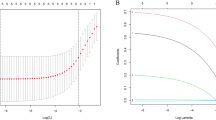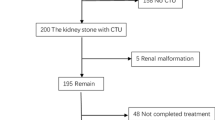Abstract
This study seeks to evaluate the recurrence of kidney stones (ROKS) nomogram for risk stratification of recurrence in a retrospective study. To do this, we analyzed the performance of the 2018 ROKS nomogram in a case–control study of 200 patients (100 with and 100 without subsequent recurrence). All patients underwent kidney stone surgery between 2013 and 2015 and had at least 5 years of follow-up. We evaluated ROKS performance for prediction of recurrence at 2- and 5-year via area under the receiver operating curve (ROC-AUC). Specifically, we assessed the nomogram’s potential for stratifying patients based on low or high risk of recurrence at: a) an optimized cutoff threshold (i.e., optimized for both sensitivity and specificity), and b) a sensitive cutoff threshold (i.e., high sensitivity (0.80) and low specificity). We found fair performance of the nomogram for recurrence prediction at 2 and 5 years (ROC-AUC of 0.67 and 0.63, respectively). At the optimized cutoff threshold, recurrence rates for the low and high-risk groups were 20 and 45% at 2 years, and 50 and 70% at 5 years, respectively. At the sensitive cutoff threshold, the corresponding recurrence rates for the low and high-risk groups were of 16 and 38% at 2 years, and 42 and 66% at 5 years, respectively. Kaplan–Meier analysis revealed a recurrence-free advantage between the groups for both cutoff thresholds (p < 0.01, Fig. 2). Therefore, we believe that the ROKS nomogram could facilitate risk stratification for stone recurrence and adherence to risk-based surveillance protocols.


Similar content being viewed by others
Data Availability
The derived data supporting the findings of this study are available from the corresponding author (NLK) on request.
References
Pearle MS, Goldfarb DS, Assimos DG et al (2014) Medical management of kidney stones: AUA guideline. J Urol 192:316–324. https://doi.org/10.1016/j.juro.2014.05.006
Forbes CM, McCoy AB, Hsi RS (2021) Clinician versus nomogram predicted estimates of kidney stone recurrence risk. J Endourol 35:847–852. https://doi.org/10.1089/end.2020.0978
Rule AD, Lieske JC, Li X et al (2014) The ROKS nomogram for predicting a second symptomatic stone episode. J Am Soc Nephrol JASN 25:2878–2886. https://doi.org/10.1681/ASN.2013091011
Vaughan LE, Enders FT, Lieske JC et al (2019) Predictors of symptomatic kidney stone recurrence after the first and subsequent episodes. Mayo Clin Proc 94:202–210. https://doi.org/10.1016/j.mayocp.2018.09.016
Iremashvili V, Li S, Penniston KL et al (2019) External validation of the recurrence of kidney stone nomogram in a surgical cohort. J Endourol 33:475–479. https://doi.org/10.1089/end.2018.0893
D’Costa MR, Pais VM, Rule AD (2019) Leave no stone unturned: defining recurrence in kidney stone formers. Curr Opin Nephrol Hypertens 28:148–153. https://doi.org/10.1097/MNH.0000000000000478
Roden DM, Pulley JM, Basford MA et al (2008) Development of a large-scale de-identified DNA biobank to enable personalized medicine. Clin Pharmacol Ther 84:362–369. https://doi.org/10.1038/clpt.2008.89
Assel M, Sjoberg D, Elders A et al (2019) Guidelines for reporting of statistics for clinical research in urology. J Urol 201:595–604. https://doi.org/10.1097/JU.0000000000000001
R Core Team (2021) R: A Language and environment for statistical computing
Fulgham PF, Assimos DG, Pearle MS, Preminger GM (2013) Clinical effectiveness protocols for imaging in the management of ureteral calculous disease: AUA technology assessment. J Urol 189:1203–1213. https://doi.org/10.1016/j.juro.2012.10.031
Rodger F, Roditi G, Aboumarzouk OM (2018) Diagnostic accuracy of low and ultra-low dose ct for identification of urinary tract stones: a systematic review. Urol Int 100:375–385. https://doi.org/10.1159/000488062
Brisbane W, Bailey MR, Sorensen MD (2016) An overview of kidney stone imaging techniques. Nat Rev Urol 13:654–662. https://doi.org/10.1038/nrurol.2016.154
Dai JC, Ahn JS, Holt SK et al (2018) National imaging trends after percutaneous nephrolithotomy. J Urol 200:147–153. https://doi.org/10.1016/j.juro.2018.01.078
Ahn JS, Holt SK, May PC, Harper JD (2018) National Imaging trends after ureteroscopic or shock wave lithotripsy for nephrolithiasis. J Urol 199:500–507. https://doi.org/10.1016/j.juro.2017.09.079
Iremashvili V, Li S, Penniston KL et al (2019) Role of residual fragments on the risk of repeat surgery after flexible ureteroscopy and laser lithotripsy: single center study. J Urol 201:358–363. https://doi.org/10.1016/j.juro.2018.09.053
Author information
Authors and Affiliations
Contributions
Nicholas Kavoussi and Ryan Hsi conceived the project, did data analysis and writing the main manuscript text. Tatsuki Koyama did the statistical analysis and generated the figures. Allison McCoy, Alexandre Da Silva, and Chase Floyd did data collection, analysis and contributed to the main text.
Corresponding author
Ethics declarations
Conflict of interest
The authors declare no competing interests.
Additional information
Publisher's Note
Springer Nature remains neutral with regard to jurisdictional claims in published maps and institutional affiliations.
Rights and permissions
Springer Nature or its licensor (e.g. a society or other partner) holds exclusive rights to this article under a publishing agreement with the author(s) or other rightsholder(s); author self-archiving of the accepted manuscript version of this article is solely governed by the terms of such publishing agreement and applicable law.
About this article
Cite this article
Kavoussi, N.L., Da Silva, A., Floyd, C. et al. Feasibility of stone recurrence risk stratification using the recurrence of kidney stone (ROKS) nomogram. Urolithiasis 51, 73 (2023). https://doi.org/10.1007/s00240-023-01446-2
Received:
Accepted:
Published:
DOI: https://doi.org/10.1007/s00240-023-01446-2




